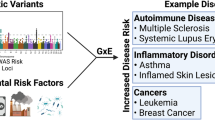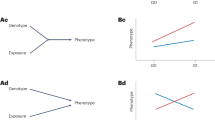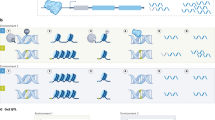Abstract
Risk of most complex diseases is determined by a combination of environmental and genetic factors. By studying gene-environment interactions, it may be possible to describe disease mechanisms, discover novel genetic variants associated with disease, better understand heterogeneity between populations, identify populations with higher risk from exposure, and target preventive and therapeutic interventions. However, there are several challenges to the study of gene-environment interactions. As technologies and analytical tools improve, opportunities to better understand the complex interplay between genes and environment may result in improved insights in disease and treatment outcomes.
Access this chapter
Tax calculation will be finalised at checkout
Purchases are for personal use only
Similar content being viewed by others
References
Alberg AJ, Brock MV, Samet JM (2005) Epidemiology of lung cancer: looking to the future. J Clin Oncol 23(14):3175–3185
Albert PS et al (2001) Limitations of the case-only design for identifying gene-environment interactions. Am J Epidemiol 154(8):687–693
Austin MA (ed) (2013) Genetic epidemiology: methods and applications, 1st edn. CABI, Wallingford
Balshaw DM, Kwok RK (2012) Innovative methods for improving measures of the personal environment. Am J Prev Med 42(5):558–559
Bjornsson HT, Fallin MD, Feinberg AP (2004) An integrated epigenetic and genetic approach to common human disease. Trends Genet 20(8):350–358
Bookman EB et al (2011) Gene-environment interplay in common complex diseases: forging an integrative model—recommendations from an NIH workshop. Genet Epidemiol 35(4):217–225
Botto LD, Khoury MJ (2001) Commentary: facing the challenge of gene-environment interaction: the two-by-four table and beyond. Am J Epidemiol 153(10):1016–1020
Burton PR, Tobin MD, Hopper JL (2005) Key concepts in genetic epidemiology. Lancet 366(9489):941–951
Cancer Genome Atlas Research Network (2011) Integrated genomic analyses of ovarian carcinoma. Nature 474(7353):609–615
Chanock SJ et al (2007) Replicating genotype-phenotype associations. Nature 447(7145):655–660
Chung CC, Chanock SJ (2011) Current status of genome-wide association studies in cancer. Hum Genet 130(1):59–78
Churchill GA et al (2004) The collaborative cross, a community resource for the genetic analysis of complex traits. Nat Genet 36(11):1133–1137
Cordell HJ (2002) Epistasis: what it means, what it doesn’t mean, and statistical methods to detect it in humans. Hum Mol Genet 11(20):2463–2468
Cornelis MC et al (2012) Gene-environment interactions in genome-wide association studies: a comparative study of tests applied to empirical studies of type 2 diabetes. Am J Epidemiol 175(3):191–202
Cortessis VK et al (2012) Environmental epigenetics: prospects for studying epigenetic mediation of exposure-response relationships. Hum Genet 131(10):1565–1589
Dempfle A et al (2008) Gene-environment interactions for complex traits: definitions, methodological requirements and challenges. Eur J Hum Genet 16(10):1164–1172
DiGiovanna JJ, Kraemer KH (2012) Shining a light on xeroderma pigmentosum. J Invest Dermatol 132(3):785–796
Eichler EE et al (2010) Missing heritability and strategies for finding the underlying causes of complex disease. Nat Rev Genet 11(6):446–450
Foley DL et al (2009) Prospects for epigenetic epidemiology. Am J Epidemiol 169(4):389–400
Fong PC et al (2009) Inhibition of poly(ADP-ribose) polymerase in tumors from BRCA mutation carriers. N Engl J Med 361(2):123–134
Garcia-Closas et al (1999) Am J Epidemiol 149:689–693
Garcia-Closas M et al (2013) Common genetic polymorphisms modify the effect of smoking on absolute risk of bladder cancer. Cancer Res 73(7):2211–2220
Gordis L (2000) Epidemiology, 2nd edn. W.B. Saunders Company, Philadelphia, p 307
Haiman CA et al (2013) Genome-wide testing of putative functional exonic variants in relationship with breast and prostate cancer risk in a multiethnic population. PLoS Genet 9(3):e1003419
Hamburg MA, Collins FS (2010) The path to personalized medicine. N Engl J Med 363(4):301–304
Hamza et al (2011) Genome-wide gene-environment study identifies glutamate receptor gene GRIN2A as a Parkinson’s disease modifier gene via interaction with coffee. PLoS Genet 7(8):e1002237
Hancock DB et al (2012) Genome-wide joint meta-analysis of SNP and SNP-by-smoking interaction identifies novel loci for pulmonary function. PLoS Genet 8(12):e1003098
Hertz DL, McLeod HL (2013) Use of pharmacogenetics for predicting cancer prognosis and treatment exposure, response and toxicity. J Hum Genet 58(6):346–352
Hindorff LA et al (2014) A catalog of published Genome-Wide Association Studies. [cited 18 Feb 2014]
Huang Y et al (2011) Genetic variants in the MRPS30 region and postmenopausal breast cancer risk. Genome Med 3(6):42
Hutter CM et al (2013) Gene-environment interactions in cancer epidemiology: a national cancer institute think tank report. Genet Epidemiol 37(7):643–657
Innocenti F, Cox NJ, Dolan ME (2011) The use of genomic information to optimize cancer chemotherapy. Semin Oncol 38(2):186–195
International HapMap Consortium et al (2007) A second generation human haplotype map of over 3.1 million SNPs. Nature 449(7164):851–861
Jirtle RL, Skinner MK (2007) Environmental epigenomics and disease susceptibility. Nat Rev Genet 8(4):253–262
Kadlubar FF, Badawi AF (1995) Genetic susceptibility and carcinogen-DNA adduct formation in human urinary bladder carcinogenesis. Toxicol Lett 82–83:627–632
Kauffmann F, Demenais F (2012) Gene-environment interactions in asthma and allergic diseases: challenges and perspectives. J Allergy Clin Immunol 130(6):1229–1240, quiz 1241-2
Khoury MJ, Wacholder S (2009) Invited commentary: from genome-wide association studies to gene-environment-wide interaction studies—challenges and opportunities. Am J Epidemiol 169(2):227–230
Knol MJ et al (2011) Estimating measures of interaction on an additive scale for preventive exposures. Eur J Epidemiol 26(6):433–438
Lander ES (2011) Initial impact of the sequencing of the human genome. Nature 470(7333):187–197
Liu CY et al (2012) Design and analysis issues in gene and environment studies. Environ Health 11(93):93
Manning AK et al (2012) A genome-wide approach accounting for body mass index identifies genetic variants influencing fasting glycemic traits and insulin resistance. Nat Genet 44(6):659–669
Manolio TA et al (2009) Finding the missing heritability of complex diseases. Nature 461(7265):747–753
Mechanic LE et al (2012) Next generation analytic tools for large scale genetic epidemiology studies of complex diseases. Genet Epidemiol 36(1):22–35
Meyer UA (2004) Pharmacogenetics – five decades of therapeutic lessons from genetic diversity. Nat Rev Genet 5(9):669–676
Meyer UA, Zanger UM (1997) Molecular mechanisms of genetic polymorphisms of drug metabolism. Annu Rev Pharmacol Toxicol 37:269–296
Mitsudomi T, Kosaka T, Yatabe Y (2006) Biological and clinical implications of EGFR mutations in lung cancer. Int J Clin Oncol 11(3):190–198
Moore JH, Williams SM (2005) Traversing the conceptual divide between biological and statistical epistasis: systems biology and a more modern synthesis. Bioessays 27(6):637–646
Moore SC et al (2012) Common genetic variants and central adiposity among Asian-Indians. Obesity 20(9):1902–1908
Mukherjee B et al (2012) Testing gene-environment interaction in large-scale case-control association studies: possible choices and comparisons. Am J Epidemiol 175(3):177–190
National Institutes of Health Consensus Development Panel (2001) National institutes of health consensus development conference statement: phenylketonuria: screening and management, October 16–18, 2000. Pediatrics 108(4):972–982
O’Huallachain M et al (2012) Extensive genetic variation in somatic human tissues. Proc Natl Acad Sci U S A 109(44):18018–18023
Piegorsch WW, Weinberg CR, Taylor JA (1994) Non-hierarchical logistic models and case-only designs for assessing susceptibility in population-based case-control studies. Stat Med 13(2):153–162
Plenge RM, Scolnick EM, Altshuler D (2013) Validating therapeutic targets through human genetics. Nat Rev Drug Discov 12(8):581–594
Poduri A et al (2013) Somatic mutation, genomic variation, and neurological disease. Science 341(6141):1237758
Price AL et al (2010) New approaches to population stratification in genome-wide association studies. Nat Rev Genet 11(7):459–463
Rahman N (2014) Realizing the promise of cancer predisposition genes. Nature 505(7483):302–308
Rappaport SM (2011) Implications of the exposome for exposure science. J Expos Sci Environ Epidemiol 21(1):5–9
Rothman KJ, Greenland S (1998) Modern epidemiology. Lippincott Williams & Wilkins, Philadelphia, p 738
Rothman KJ, Greenland S, Walker AM (1980) Concepts of interaction. Am J Epidemiol 112(4):467–470
Shi M, Umbach DM, Weinberg CR (2011) Family-based gene-by-environment interaction studies: revelations and remedies. Epidemiology 22(3):400–407
Siemiatycki J, Thomas DC (1981) Biological models and statistical interactions: an example from multistage carcinogenesis. Int J Epidemiol 10(4):383–387
Smith PG, Day NE (1984) The design of case-control studies: the influence of confounding and interaction effects. Int J Epidemiol 13(3):356–365
Spiegelman D (2010) Approaches to uncertainty in exposure assessment in environmental epidemiology. Annu Rev Public Health 31:149–163
The 1000 Genomes Project Consortium (2012) An integrated map of genetic variation from 1,092 human genomes. Nature 491(7422):56–65
Thomas D (2004) Statistical methods in genetic epidemiology. Oxford University Press, New York
Thomas D (2010) Gene–environment-wide association studies: emerging approaches. Nat Rev Genet 11(4):259–272
Thomas DC et al (2012) Invited commentary: GE-whiz! ratcheting gene-environment studies up to the whole genome and the whole exposome. Am J Epidemiol 175(3):203–207
Thompson WD (1991) Effect modification and the limits of biological inference from epidemiologic data. J Clin Epidemiol 44(3):221–232
Turek-Plewa J, Jagodzinski PP (2005) The role of mammalian DNA methyltransferases in the regulation of gene expression. Cell Mol Biol Lett 10(4):631–647
VanderWeele TJ (2011) A word and that to which it once referred assessing “biologic” interaction. Epidemiology 22(4):612–613
VanderWeele TJ, Vansteelandt S (2014) Invited commentary: some advantages of the relative excess risk due to interaction (RERI)–towards better estimators of additive interaction. Am J Epidemiol 179(6):670–671
Veeck J et al (2010) BRCA1 CpG island hypermethylation predicts sensitivity to poly(adenosine diphosphate)-ribose polymerase inhibitors. J Clin Oncol 28(29):e563–e564, author reply e565–566
Vineis P, Perera F (2007) Molecular epidemiology and biomarkers in etiologic cancer research: the new in light of the old. Cancer Epidemiol Biomarkers Prev 16(10):1954–1965
Weinberg CR (2012) Interaction and exposure modification: are we asking the right questions? Am J Epidemiol 175(7):602–605
Wild CP (2005) Complementing the genome with an “exposome”: the outstanding challenge of environmental exposure measurement in molecular epidemiology. Cancer Epidemiol Biomarkers Prev 14(8):1847–1850
Wild CP (2012) The exposome: from concept to utility. Int J Epidemiol 41(1):24–32
Witte JS, Gauderman WJ, Thomas DC (1999) Asymptotic bias and efficiency in case-control studies of candidate genes and gene-environment interactions: basic family designs. Am J Epidemiol 149(8):693–705
Wu C et al (2012) Genome-wide association analyses of esophageal squamous cell carcinoma in Chinese identify multiple susceptibility loci and gene-environment interactions. Nat Genet 44(10):1090–1097
Zanger UM, Raimundo S, Eichelbaum M (2004) Cytochrome P450 2D6: overview and update on pharmacology, genetics, biochemistry. Naunyn Schmiedebergs Arch Pharmacol 369(1):23–37
Zhang W, Dolan ME (2010) Impact of the 1000 genomes project on the next wave of pharmacogenomic discovery. Pharmacogenomics 11(2):249–256
Zuk O et al (2014) Searching for missing heritability: designing rare variant association studies. Proc Natl Acad Sci U S A 111(4):E455–E464
Author information
Authors and Affiliations
Corresponding author
Editor information
Editors and Affiliations
Rights and permissions
Copyright information
© 2015 Springer-Verlag London
About this chapter
Cite this chapter
Mechanic, L.E., Hutter, C.M. (2015). Gene-Environment Interactions in Human Health. In: Su, L., Chiang, Tc. (eds) Environmental Epigenetics. Molecular and Integrative Toxicology. Springer, London. https://doi.org/10.1007/978-1-4471-6678-8_10
Download citation
DOI: https://doi.org/10.1007/978-1-4471-6678-8_10
Publisher Name: Springer, London
Print ISBN: 978-1-4471-6677-1
Online ISBN: 978-1-4471-6678-8
eBook Packages: Biomedical and Life SciencesBiomedical and Life Sciences (R0)




